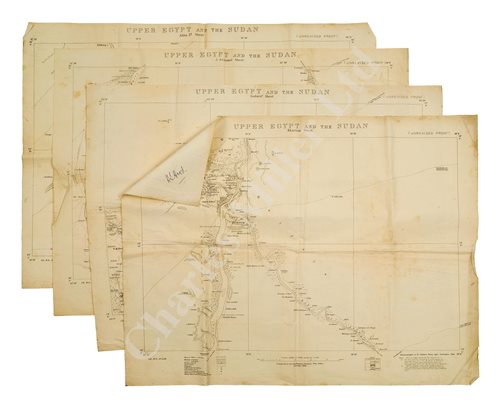6th Nov, 2018 11:00
Maritime and Scientific Models, Instruments & Art ('Speedy')
87
[M] AN HISTORICALLY INTERESTING SET OF FOUR WAR OFFICE-ISSUED CHARTS OF UPPER EGYPT AND THE SUDAN, USED BY LT. HORACE HOOD TO GUIDE THE GUN BOAT NASR TO SUPPORT THE BATTLE OF OMDURMAN, 1898
AN HISTORICALLY INTERESTING SET OF FOUR WAR OFFICE-ISSUED CHARTS OF UPPER EGYPT AND THE SUDAN, USED BY LT. HORACE HOOD TO GUIDE THE GUN BOAT NASR TO SUPPORT THE BATTLE OF OMDURMAN, 1898
compiled by the intelligence division of the War Office in January 1898 and 'photozincographed' on linen by the Ordnance Survey with subtitles Khartum Sheet; J. Arashkol Sheet; Abba Id Sheet; and Gedaref Sheet, each complete with keys, scale, notes etc., signed on reverse HL Hood and inscribed for either Blue Nile or White Nile and numbered, each -- 22 x 28½in. (56 x 72.5cm.)
Lead by General Kitchener, the Battle of Omdurman was a direct response to the death of General Gordon at Khartoum in 1886. One of the last grand exercises of Empire, Kitchener's troops, supplemented by the Camel Corps and eight gunboats, advanced up the Blue and White Nile to recapture the Sudan from the Mahdi. Taking no chances Kitchener's highly disciplined troops were armed with modern rifles, machine guns and artillery backed up by the gunboats. By contrast, whilst the Dervish army had some guns, they included flintlocks, and some were found to be wearing chain-mail captured from Christian knights in the Crusades. It was also the scene of the British Army's last cavalry charge, in which the young Winston Churchill took part. Lt. Horace Hood (1870-1916) captained the gunboat Nasr in a squadron commanded by David Beatty. Descended from a long line of famous naval officers, he was the great-great grandson of Admiral Samuel Hood. He became a Rear-Admiral but died at Jutland when his ship, the battlecruiser Invincible, blew up causing Admiral Beatty to comment "there's something wrong with our bloody ships today".
AN HISTORICALLY INTERESTING SET OF FOUR WAR OFFICE-ISSUED CHARTS OF UPPER EGYPT AND THE SUDAN, USED BY LT. HORACE HOOD TO GUIDE THE GUN BOAT NASR TO SUPPORT THE BATTLE OF OMDURMAN, 1898
compiled by the intelligence division of the War Office in January 1898 and 'photozincographed' on linen by the Ordnance Survey with subtitles Khartum Sheet; J. Arashkol Sheet; Abba Id Sheet; and Gedaref Sheet, each complete with keys, scale, notes etc., signed on reverse HL Hood and inscribed for either Blue Nile or White Nile and numbered, each -- 22 x 28½in. (56 x 72.5cm.)
Lead by General Kitchener, the Battle of Omdurman was a direct response to the death of General Gordon at Khartoum in 1886. One of the last grand exercises of Empire, Kitchener's troops, supplemented by the Camel Corps and eight gunboats, advanced up the Blue and White Nile to recapture the Sudan from the Mahdi. Taking no chances Kitchener's highly disciplined troops were armed with modern rifles, machine guns and artillery backed up by the gunboats. By contrast, whilst the Dervish army had some guns, they included flintlocks, and some were found to be wearing chain-mail captured from Christian knights in the Crusades. It was also the scene of the British Army's last cavalry charge, in which the young Winston Churchill took part. Lt. Horace Hood (1870-1916) captained the gunboat Nasr in a squadron commanded by David Beatty. Descended from a long line of famous naval officers, he was the great-great grandson of Admiral Samuel Hood. He became a Rear-Admiral but died at Jutland when his ship, the battlecruiser Invincible, blew up causing Admiral Beatty to comment "there's something wrong with our bloody ships today".
Auction: Maritime and Scientific Models, Instruments & Art ('Speedy'), 6th Nov, 2018
Page turning catalogue here
Downloadable bid form here
Main View and Sale Venue:
25 Blythe Road
London, W14 0PD
Large Object View and Post-Sale Collection:
6 Imperial Studios
3-11 Imperial Road
London, SW6 2AG
Press enquiries: Suzanne Trisk press@charlesmillerltd.com
Viewing
Saturday, 3rd November
(12noon-5pm)
Sunday, 4th November
(12noon-5pm)
Monday, 5th November
(10am-5pm)
Tuesday, 6th November
(10am-11am - limited view only)
